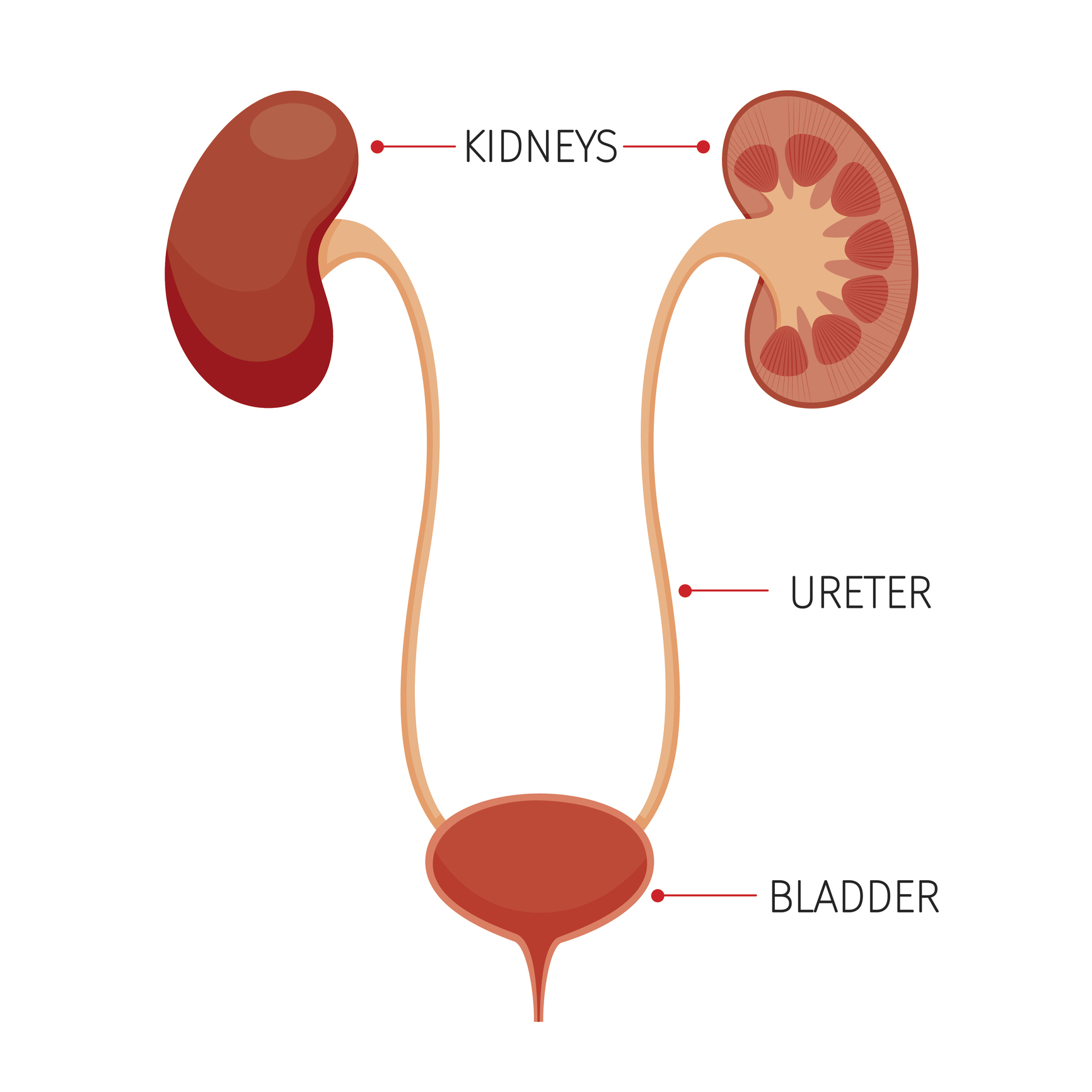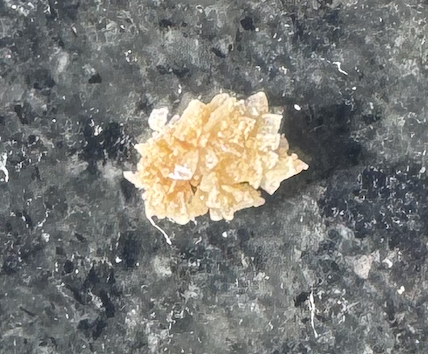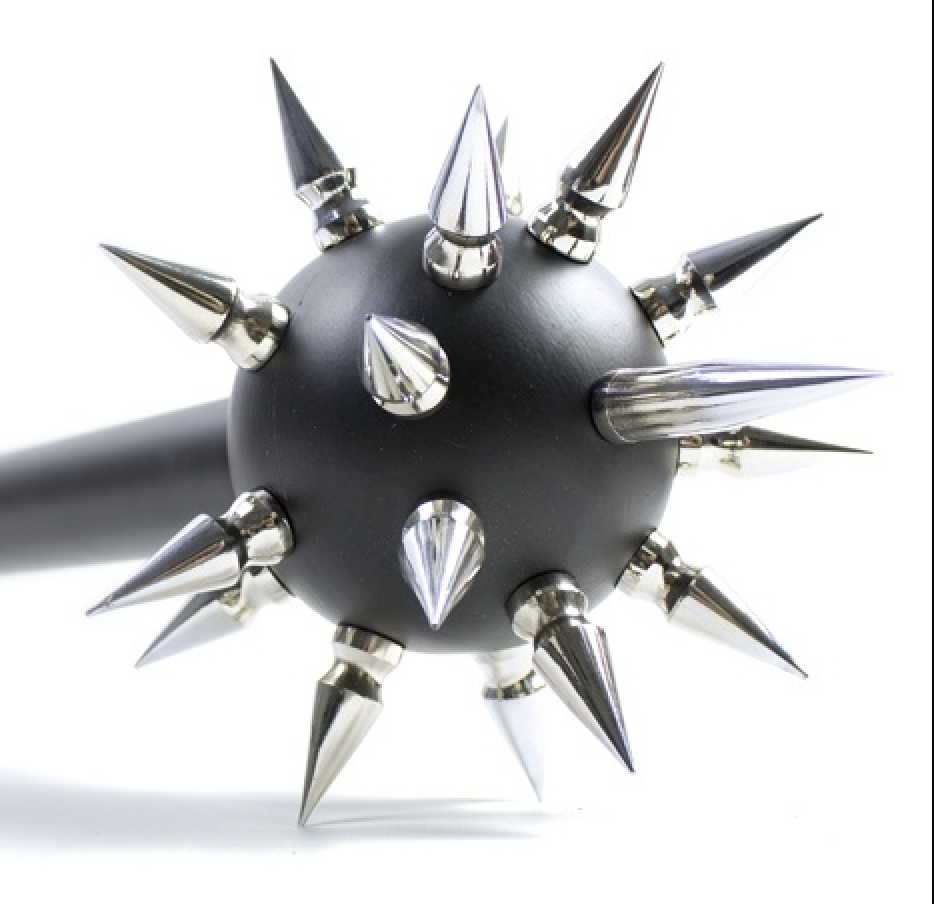The Missing Kidney Stone Manual
- What it is
- Why Pain
- The Journey
- My Urologists recommendation to prevent them in the future
- Medication
- Final thoughts
I had a kidney stone in January 2025. I was absolutely shocked how little information was out there on what I would go through. THIS IS NOT MEDICAL ADVICE. It is me documenting what I went through and what I wish I knew going in.
I want to state up front:
- I am male and some of this information is specific to my equipment.
- There are explicit descriptions of uncomfortable and/or icky things here. Be warned.
NOTE: on Feb 13, 2025 I got the news that the kidney stone composition was calcium oxalate dihydrate.
What it is
Crystals can form in your kidneys, for reasons, and when they get big enough they are called stones. I’ve known people who had really large ones that were stuck in the kidney (due to their size) and had to be surgically removed. If they are small enough they can pass from your kidney to your bladder and out into the world. Here’s the anatomy lesson:

My stone was 3mm. Pretty small, all things considered. This is the actual spikey bastard:

Not the best picture, but you can see it’s not round. That’s the first misconception I had with kidney stones, that they are round and smooth. And it’s not smooth. More on that later.
Why Pain
When the spikey bastard moves from the kidney down the ureter toward the bladder is when the fun begins. The pain usually starts in the flank. Your lower back, off to one side (depending on which kidney the stone is in), above your hip bone. The pain will appear, rise in intensity, hit a maximum and then drop off again to nothing. This is the way a lot of people experience it. Waves of pain, then periods of no pain. Those periods of no pain can be long or short.
As the spikey bastard moved through the kidney, into the ureter, into the bladder, into the prostate and finally into the urethra it causes bleeding. That bleeding will make your urine look dark and orange-ish.
Below, I will use the 1-10 scale of pain, 10 being the maximum you can imagine. 0 being no pain.
The Journey
Keep in mind, I captured my urine to capture the stone. I did not want it escaping down the toilet. I want it to be analyzed by a lab to know what type it is, so I can take preventative actions so I do not go through this again.
Day 0
I drank more water than usual the day before, but I urinated much less than expected and when I did it was dark and sort of in orange color. It was a little worrying, but I decided I was probably mis-remembering the amount of hydration. ⚡foreshadowing detected⚡
Day 1
At 3am, I woke up and noticed some flank pain, probably a 0.5 for 10 minutes (henceforth 0.5p/10m). I was confused, but after thinking about it a few minutes I was like “uh, oh… is this a kidney stone???” I tried to go back to sleep, but couldn’t.
4 hours later it happened again (2p/20m).
2.5 hours later it happened again and was an 8 or 9 pretty immediately. I was in so much pain I didn’t think I could walk upstairs. I was able to make it upstairs and immediately called 911. They arrived in 5 minutes, and by the time we got to the ER it was gone. So, the pain was 9p/15m. I want to point out that 15 minutes is a long time to be at a 9. There were times I didn’t know if I could withstand it.
While at the ER I got fluids and when I started to pee I had flank pain at about a 2, which would go away when I lay back down.
Also, while in the ER, they ran a battery of blood tests, all of which came back normal except the ones that detected blood in my urine. I had a lot of blood there. They also did a CAT scan and found the sole 3mm stone was almost to the bladder. Whew, I thought. ⚡foreshadowing detected⚡
That evening, I had a spikes of flank pain, probably a 6, that lasted for an hour. This happened a few times through the night.
I had hydrated a lot during the day and I feel I didn’t really urinate as much as I thought I should have. ⚡foreshadowing detected⚡
In the ER, I was given a prescription for Flowmax (aka Tamsulosin), to help with getting the spikey bastard out. Apparently it makes the ureter smooth, to facilitate the journey. We want the spikey bastard to be comfy, right?!
Day 2
I was able to sleep only a few hours.
The phenomenal ER nurse told me I would feel it move from my flank around to the front, literally in a line toward my crotch and toward my the base of my penis. And, indeed, that is what I felt, over the course of a couple of hours. It wasn’t too painful. Probably a 1-2, intermittently. It was a very weird feeling, though. I would look down at my waist and imagine it moving through the ureter.
Around 9:30am I had to urinate really badly. I believe that is when the spikey bastard moved from ureter to bladder. It sort of opened a flood gate, so to speak.
At this point, I thought it was all over, having forgotten about the ER nurse comment above. ⚡foreshadowing detected⚡
Day 15
I had flank pain around 5am that was similar to the initial pain on day 1. I freaked out that I had a new stone that made it into my ureter.
Kaiser got me to a Dr who told me it was probably referred pain from the original stone, still moving through my system. After all, I had not seen the spikey bastard, so I thought this was likely. I hydrated like crazy all day and had no further pain.
Day 17
I had a really odd sensation in the area where my prostate is. I really struggle to describe the sensation, because it so unlike anything I’ve ever felt. I’ll call it a low-level tickle in that area. It was neither unpleasant or painful. It just was. It was with me for days and I learned to ignore it.
I assumed then and now that the spikey bastard had left my bladder and entered my prostate. I was hoping it wouldn’t stay there long and would soon be available for pictures.
Day 20 (approx)
I stopped taking Flowmax/Tamsulosin because I didn’t feel like it was really doing anything and I had watched a video from the Buck Institute that said any new symptom, in geriatric patients, was assumed to be caused by existing/new medications. I was having unrelated medical issues and decided it was best to remove this from my regimen.
Day 24
I had a weird shooting pain in my testicles. Didn’t last long, was probably a 4, but very brief. Happened like 2-3 times. Then never again.
Day 25
During the day, while urinating, it felt like something spikey had left my prostate and was making a break for freedom. It wasn’t really that painful, probably a 1, but it wasn’t comfortable, either. I hydrated a lot that day but I couldn’t seem to get it to move.
This is what I pictured in my mind’s eye:

Day 26
The spikey bastard moved to within 2 inches of freedom. This was not a pleasant feeling. I would say this state persisted for 4-5 hours. For all of that I was hydrating like crazy and most of it I was sitting still. The pain varied from 1-4, but it was weird pain. Very hard to describe.
After urinating about 5 times, it finally saw the light of day. It was free. I plan to give it to my Dr for analysis, to see what it’s made of, because that should tell me what I need to do to prevent one in the future.
My Urologists recommendation to prevent them in the future
This was the entire contents of the last message my urologist sent me (unedited, other than formatting):
-
Please increase your fluid intake to reach a goal of at least 2 liters of urine daily. You will likely need to drink 2.5 - 3 liters of fluid a day to do this. The good news is that almost any fluid counts towards this 2.5 – 3 liter total, but water is best. Carry a water bottle with you. It is important that you drink water multiple times a day. You may need to get up at night once to urinate, which is okay.
-
Water is best, but you may have flavored water (crystal light), mineral water or citrus juices. Any fluid is beneficial EXCEPT for colas, canned juice (high in sodium) and cranberry juice (high in oxalate). Coffee and tea are okay in small amounts, although some teas are very high in oxalate. You can also add some dilute lemonade or lemon juice to your diet to increase your citrate consumption which prevents stones. One option is to add 120ml of concentrated lemon juice to 2 liters of water and drink throughout the day.
-
Please reduce your dietary salt intake by reducing the use of the salt shaker, using potassium based salt substitute (Mrs. Dash, for example), eating out less (limit to 1-2 times a week at most), and being aware of the sodium content of foods when shopping. *Limit sodium intake (<2000mg/day). Most salt intake comes in prepared food. Remember “The 5 Rule”: Avoid foods in which the word salt or sodium is listed in the first 5 ingredients.
-
Please reduce your total animal protein intake during individual meals. It is better to have multiple small portions (3 ounces) of animal protein throughout the day than one large protein-rich meal. A diet rich in fruits, vegetables and fiber lowers your risk of stone formation. A high animal protein diet increases urinary calcium and oxalate and decreases citrate levels and urinary pH, all of which increases your risk of stones.
-
A normal amount of calcium in the diet is actually beneficial. If your calcium intake is too low or too high it can lead to stones. A normal amount of calcium of about 1200mg per day should be maintained in your diet. Please add a half of cup of yogurt, milk or take a calcium citrate pill with meals, especially meals with high oxalate content (lunch and dinner). It is important not to reduce your calcium intake; this is true even if your stone was made out of ‘calcium.’ Four 8 oz. glasses of milk equals 1,200mg calcium. Any calcium supplements must be taken with a meal.
-
Please continue to eat a healthy diet with lots of fruit and vegetables but try to avoid a few extremely high oxalate foods such as spinach, beets, almonds and tofu. Avoid excess vitamin C as well.
Medication
On pain medication, I was given zofran in the ambulance by EMS. I was given toradol in the ER. The nurse said it worked better than opiates and that opiates didn’t work very well for kidney stones. Speaking of which, I was given an oxy prescription during discharge at the ER and I filled it, but I didn’t take any of it. I’m extremely wary of oxy, for obvious reasons. I wish I didn’t waste the $15 copay. Now I think I’ll just take it back to Kaiser for disposal. I don’t want that stuff in the house.
While I was still passing the stone into my bladder I did a combination of Tylenol and Aleve. I did the max dose of both, staggered, for probably 24 hours.
Final thoughts
I know everyone has a different experience with kidney stones, but I suspect that much of what I experienced I share with other sufferers of kidney stones.
I was just shocked how little information was available anywhere on the internet. I looked everywhere. I spend hours searching. ChatGPT, et al. Google. Medical websites. Almost none of what I wrote above was available.
I wrote all of this on the off chance it one of my fellow travelers.